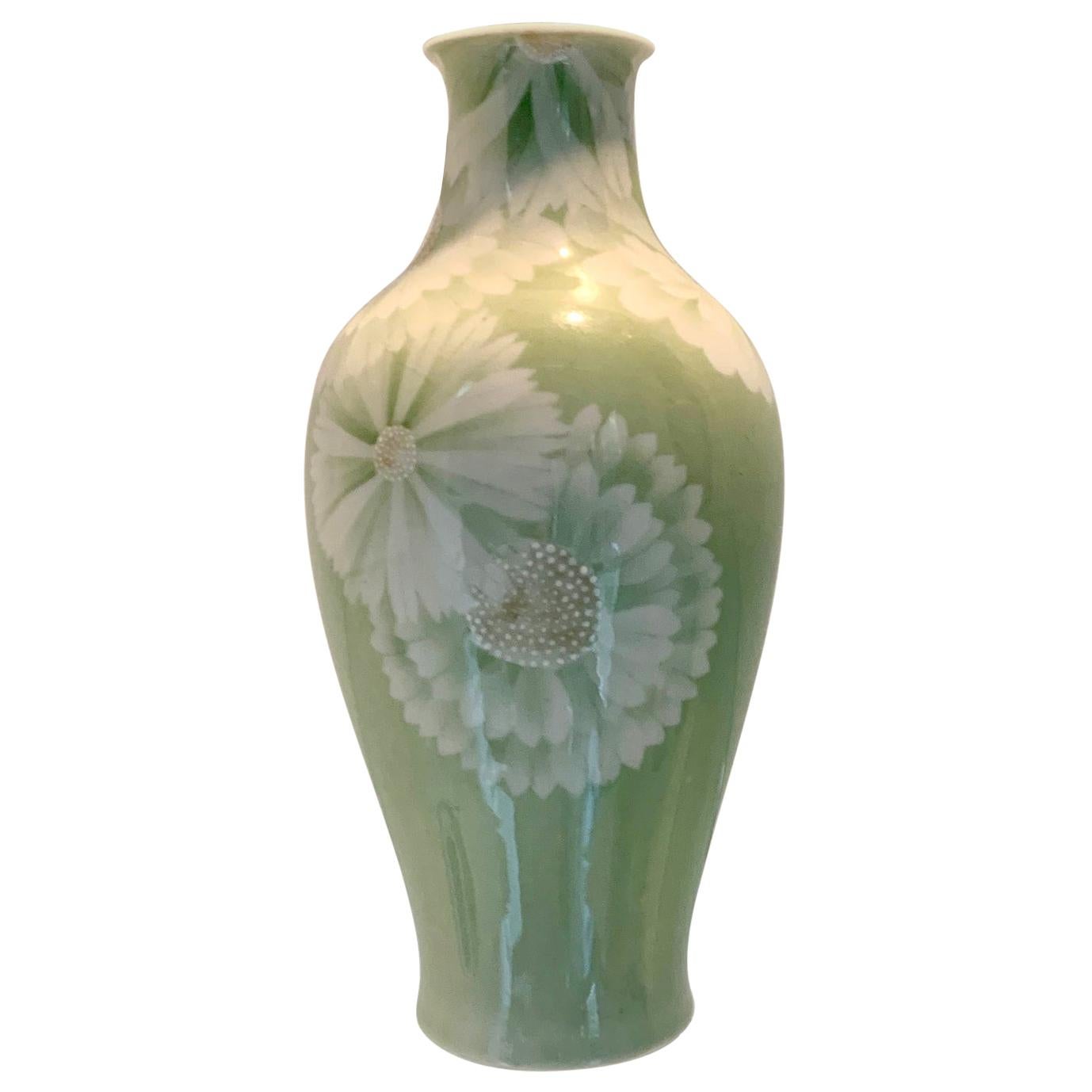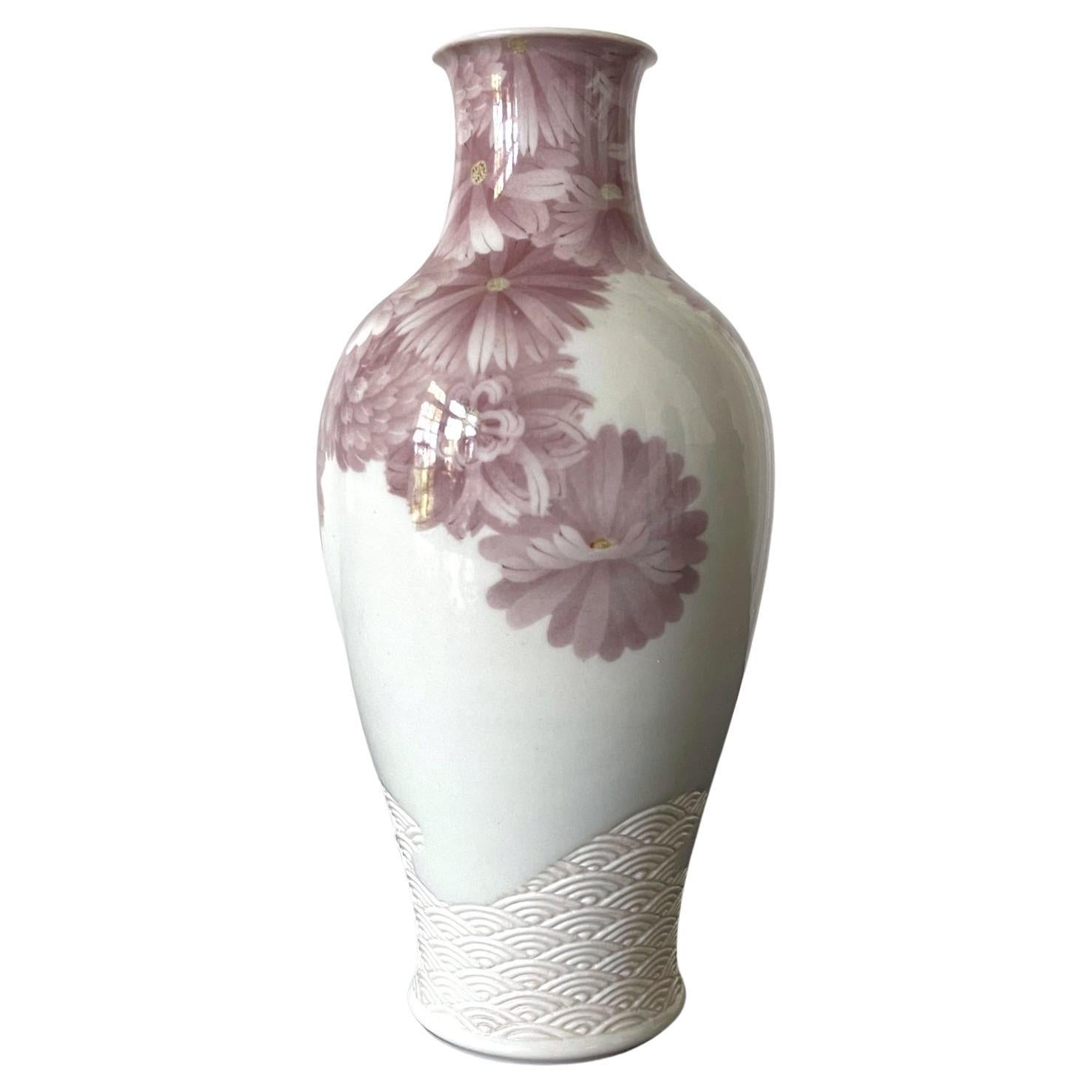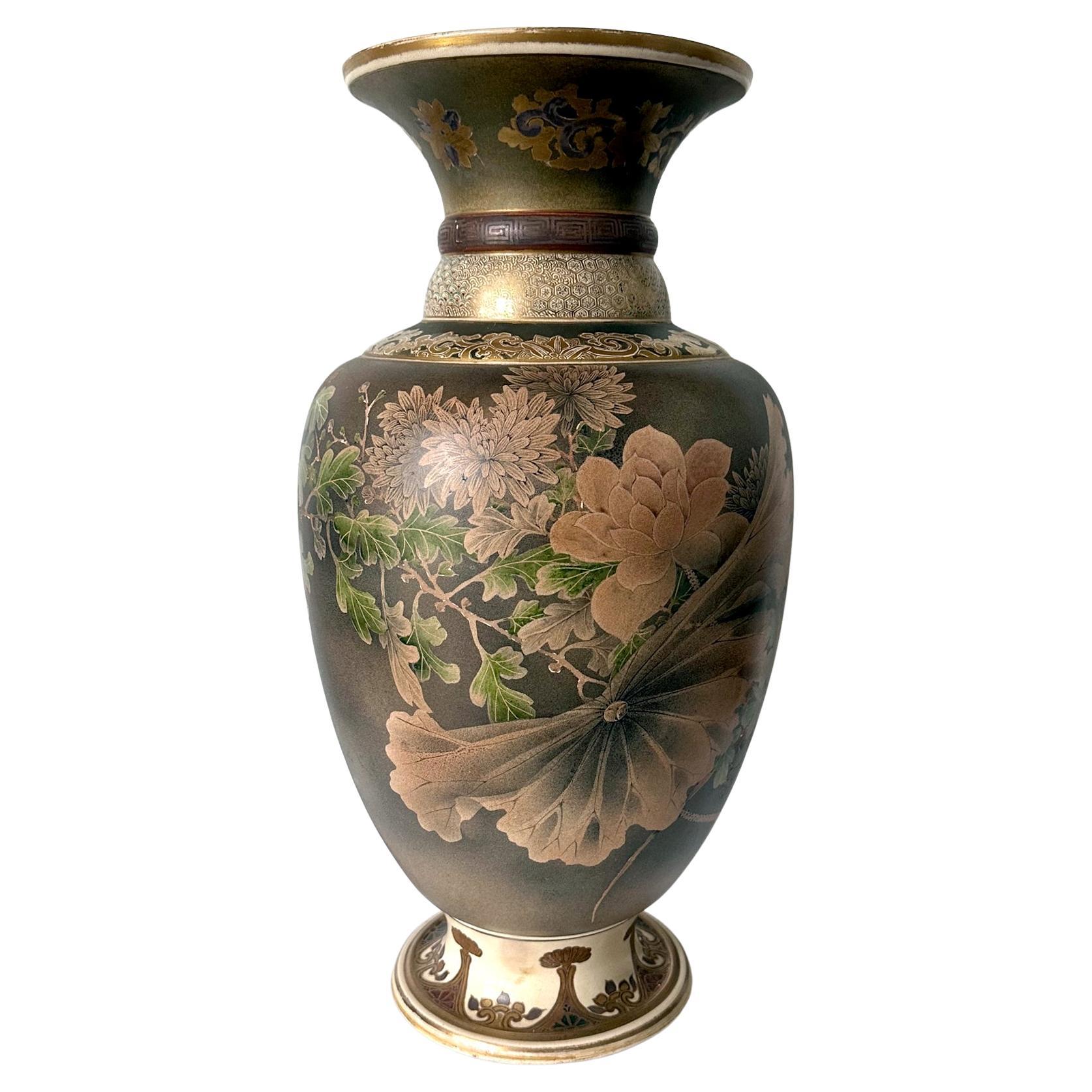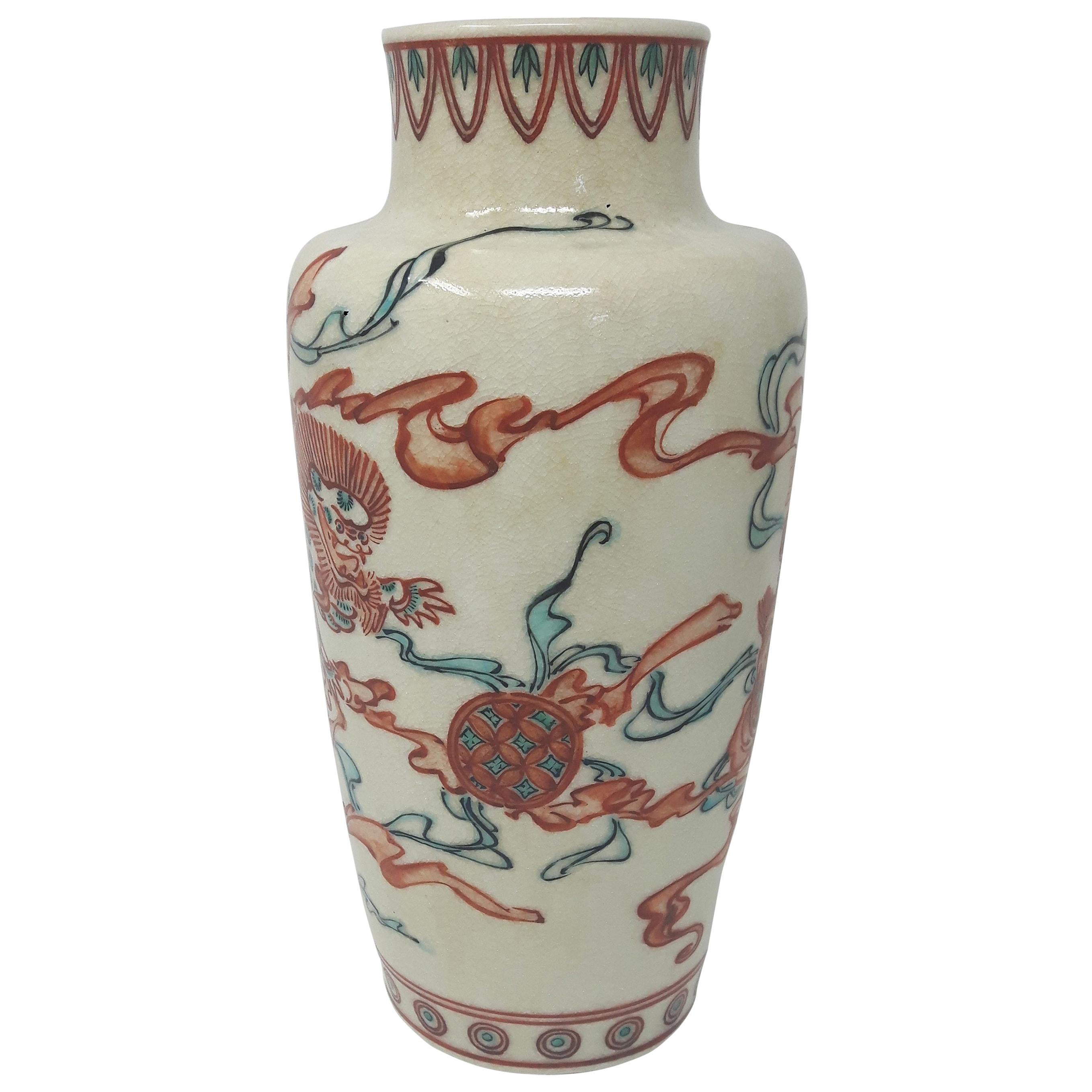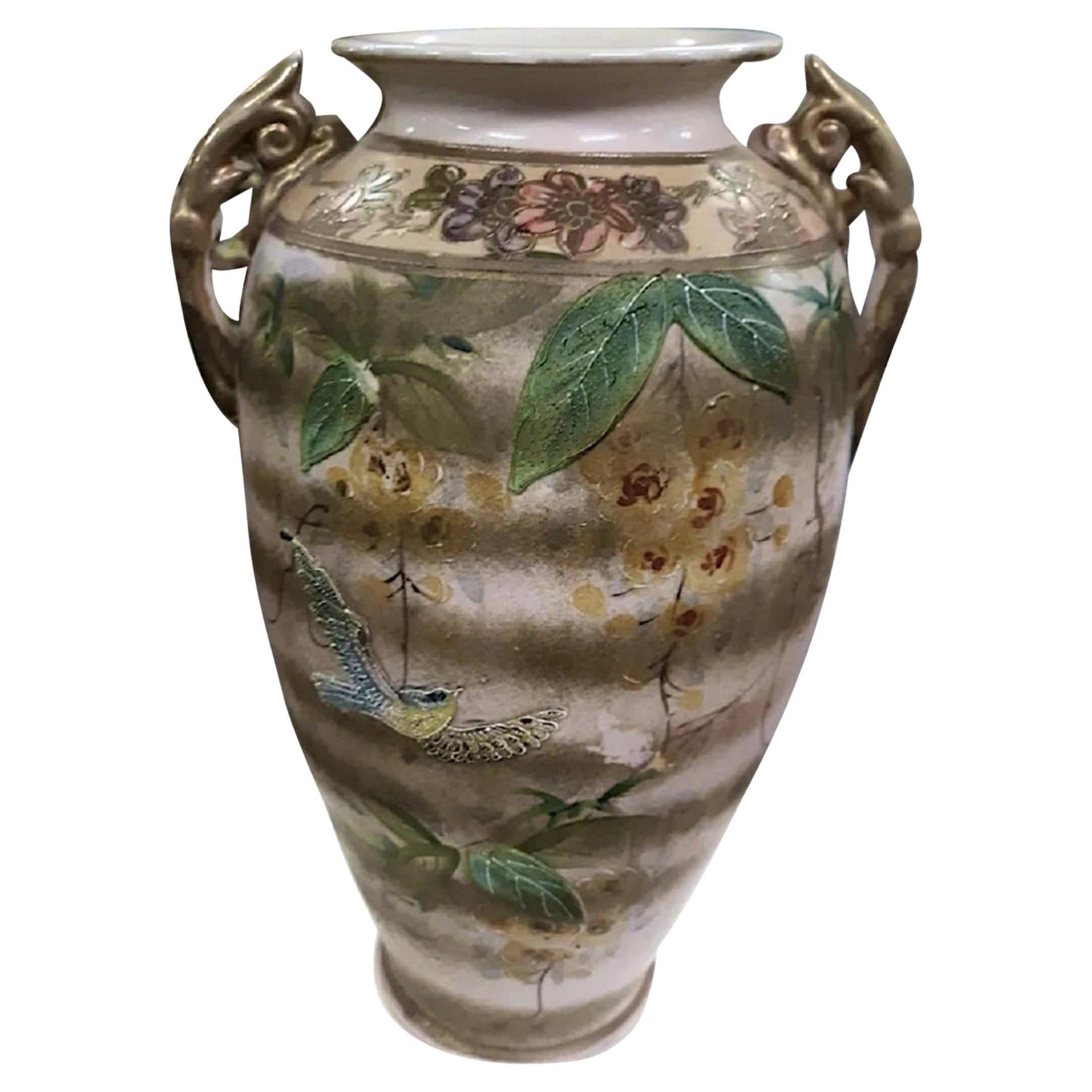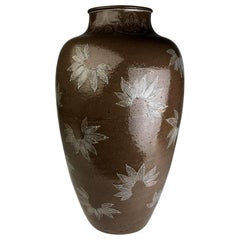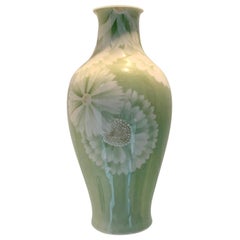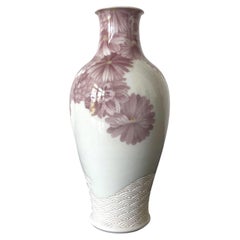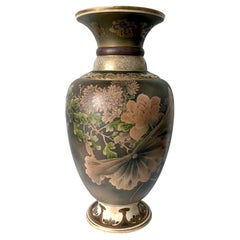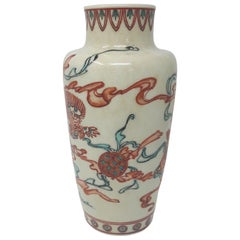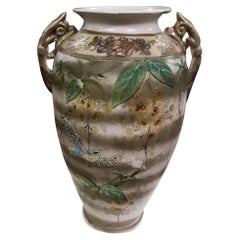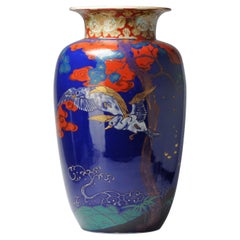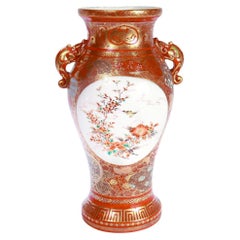Items Similar to Japanese Porcelain Vase with Relief Surface Makuzu Kozan
Want more images or videos?
Request additional images or videos from the seller
1 of 18
Japanese Porcelain Vase with Relief Surface Makuzu Kozan
$8,500
£6,498.70
€7,485.19
CA$11,911.11
A$13,297.63
CHF 6,967.76
MX$162,776.04
NOK 88,490.60
SEK 83,435.40
DKK 55,862.76
Shipping
Retrieving quote...The 1stDibs Promise:
Authenticity Guarantee,
Money-Back Guarantee,
24-Hour Cancellation
About the Item
A rare porcelain vase by Makuzu Kozan (1842-1916) circa 1870-81 (late Meiji period). The vase is dated to the earlier work from Kozan's studio during his early period (Takauki-ware period, 1876-1881), when surface relief sculpturing was used as a distinguished technique. Not a large quantity of the examples remained.
The vase features a classic form of a storage jar with short neck and wide round mouth and raised shoulder. The entire surface was decorated with fine horizontal lines of ring, upon which enamel paintings of magpie birds in flight and swaying autumn grasses. The low relief sculpturing depicts a scrolling grape vines with leaves and clusters of grapes, all rendered in a highly realistic manner with colors. Together, it forms a lovely autumn scenery. The vase is marked with a branded gourd seal "Makuzu Kozan" underneath.
For a similar takauki vase with grape decoration, see Retrospective Makuzu Kozan Miyagawa Collection Book: page 131.
- Creator:Makuzu Kozan (Artist)
- Dimensions:Height: 10.5 in (26.67 cm)Diameter: 7 in (17.78 cm)
- Style:Japonisme (Of the Period)
- Materials and Techniques:
- Place of Origin:
- Period:
- Date of Manufacture:1876-81
- Condition:Wear consistent with age and use. minor surface wear such as rubbing losses of gilt on spots, a couple of fire kiln firing cracks on the vines as shown as well as rings in the interior base as shown, contact wear on the base rim.
- Seller Location:Atlanta, GA
- Reference Number:1stDibs: LU945021925612
About the Seller
4.9
Platinum Seller
Premium sellers with a 4.7+ rating and 24-hour response times
Established in 2006
1stDibs seller since 2010
564 sales on 1stDibs
Typical response time: <1 hour
- ShippingRetrieving quote...Shipping from: Atlanta, GA
- Return Policy
Authenticity Guarantee
In the unlikely event there’s an issue with an item’s authenticity, contact us within 1 year for a full refund. DetailsMoney-Back Guarantee
If your item is not as described, is damaged in transit, or does not arrive, contact us within 7 days for a full refund. Details24-Hour Cancellation
You have a 24-hour grace period in which to reconsider your purchase, with no questions asked.Vetted Professional Sellers
Our world-class sellers must adhere to strict standards for service and quality, maintaining the integrity of our listings.Price-Match Guarantee
If you find that a seller listed the same item for a lower price elsewhere, we’ll match it.Trusted Global Delivery
Our best-in-class carrier network provides specialized shipping options worldwide, including custom delivery.More From This Seller
View AllRare Large Vase with White Slip Inlay Makuzu Kozan Meiji Period
By Makuzu Kozan
Located in Atlanta, GA
A impressively large and unusual stoneware vase in an urn shape from the studio of Japanese Potter Makuzu Kozan, also known as Miyagawa Kozan (1842–1916), one of the most established and collected ceramist from Meiji Period. Born as Miyagawa Toranosuke, Kozan established his pottery studio in Yokohama circa 1870s and later became one of the appointed artist to the Japanese Imperial household. His work was exhibited in many international fairs that the Meiji government participated at the turn of the century and won many grand prizes.
This vase is dated to the end of Makuzu's life circa 1910-1916 based on similar work created around that time. After achieving domestic and international fame, Makuzu retired and handed the business to his son Hanzan in 1912. He dedicated his time to other selected projects that were more in tune with Japanese sensibility than export aesthetic. He made a group of stoneware pottery pieces inspired by Edo master like Ninsei and Kenzan as well as his own poetic creation. This piece is attributed to that period.
Standing of an impressive size, this vase is more like an urn, made with stoneware instead of porcelain. It was coated with a brown iron glaze with a slight translucent quality. Underglaze whit slips were used to draw low relief decoration of bamboo leaves that sparsely scatter on the surface. Slightly more elaborate scrolling vines and autumn flowers circles under the mouth rim. Same white slip inlay was used to sign the vase under the base. The whole effect of the piece is unusual. With its dark glaze in contrast with the sparse white decoration that is more abstract and geometric than realistic, it appears almost modern with an Art Deco flavor.
For stoneware urn and vase in the similar genre by Makuzu Kozan: see figure 113 on page 182 of "Sekai ni Aisa Reta ya Kimono" MIYAGAWA KOZAN MAKUZU...
Category
Vintage 1910s Japanese Japonisme Ceramics
Materials
Ceramic
Japanese Porcelain Vase Meiji Period Makuzu Kozan
By Makuzu Kozan
Located in Atlanta, GA
A finely decorated and glazed Japanese porcelain vase by Makuzu Kozan (1842-1916) circa 1900s Meiji Period. The vase is of a classic bottle form with baluster body and short neck. It was decorated with underglaze white magnolia blossom on a pleasant celadon background. The stamens of the flower were artistically rendered in a low relief, giving the design a realistic appeal with the dimension.
Miyagawa Kozan...
Category
Early 20th Century Japanese Meiji Ceramics
Materials
Porcelain
Japanese Ceramic Vase with Delicate Carvings by Makuzu Kozan Meiji Period
By Makuzu Kozan
Located in Atlanta, GA
A delicate and rare Japanese ceramic vase by the important Meiji imperial potter Makuzu Kozan (1842-1916) circa 1887-1910. Dated to his underglaze phase post 1887 after he successful...
Category
Antique 1890s Japanese Japonisme Ceramics
Materials
Ceramic
Large Japanese Satsuma Ceramic Vase Kinkozan
By Kinkozan
Located in Atlanta, GA
A large Japanese ceramic vase from the end of Meiji period circa 1890-1910s by Kinkozan (1645-1927). One of the largest studio manufacturers of the export ceramics at the time based in Kyoto. In the typical style of satsuma made at the turn of 20th century, the vase is elaborately decorated with a rather unusual kinran-de (gold paint) and green enamel highlight on a mottled brown background. The painterly decoration depicts a large seasonal floral arrangement in a circular fashion. Besides the obviously superb craftsmanship, what sets this particular vase apart from many lower quality and mass-produced pieces is its tone-on-tone color pallet that is visually somber and the small and sensitive details that heralds the change of the seasons. When the viewer goes beyond the first casual glimpse of the blossom and foliage, one would notice that on the edges of certain leaves as well as along the stalks, there accumulates a very thin layer of the white dust that represents the frost. The flower in bloom are chrysanthemums. Despite of being splendid, they are the messengers of the autumn. The large lotus leaf was subtly rendered in a bended and slightly withered manner, just past its prime. Although the lotus is still in bloom, the prominent seed pod indicates it may be the last for the season. The sentimental capture of the change of the seasons is not unusual in Japanese art. This vase poetically represents such a subtle transition from summer to fall, perhaps depicting the very first frost.
The neck of the vase is also slightly unusual with two rolled rings...
Category
Early 20th Century Japanese Meiji Ceramics
Materials
Ceramic
Japanese Porcelain Vase Makuzu Kozan Meiji Period
By Makuzu Kozan
Located in Atlanta, GA
A striking blue and white vase from the studio of Japanese Potter Makuzu Kozan, also known as Miyagawa Kozan (1842–1916), one of the most established and collected ceramist from Meiji Period. Born as Miyagawa Toranosuke, Kozan established his pottery studio in Yokohama circa 1870s and later became one of the appointed artists to the Japanese Imperial household. His work was exhibited in many international fairs that the Meiji government participated at the turn of the century and won many grand prizes.
Of a relatively large size, this vase is decorated with underglaze cobalt blue using the novel technique developed by Kozan called Fuki-e (the blow painting). As a result, the bamboos appear took on a three-dimensional quality as if appearing in a mist. Known as one of the most creative ceramists, circa 1887, Kozan started experimenting with new chemical colors from the West in the format of his porcelain glaze. New colors allowed him to create underglaze design that appeared bright, smooth and glossy. He even invented his own receipt of cobalt blue to achieve a much brighter yet softer shade, as evident on this vase. To create landscape that is realistic and dimensional, more common in the western paintings, he was inspired by the native Japanese ink painting technique developed around 1900 by Yokoyama Taikan...
Category
Antique Early 1900s Japanese Japonisme Ceramics
Materials
Ceramic
Rare and Large Japanese Porcelain Vase Makuzu Kozan
By Makuzu Kozan
Located in Atlanta, GA
A striking blue and white vase from the studio of Japanese Potter Makuzu Kozan, also known as Miyagawa Kozan (1842–1916), one of the most established and collected ceramist from Meiji Period. Born as Miyagawa Toranosuke, Kozan established his pottery studio in Yokohama around 1870s and later became one of the appointed artist to the Japanese Imperial household. His work was exhibited in many international fairs that the Meiji government participated at the turn of the century and won many grand prizes.
With an impressively large size, this vase was likely made and reserved as a presentation piece for one of the many expositions the studio participated in the early 20th century. It was decorated with underglaze cobalt blue using the novel technique developed by Kozan called Fuki-e (the blow painting), in order to achieve the striking dimensional literary landscape known as "Mountain and Water". Being one of the most creative ceramists, Kozan started experimenting with new chemical colors from the West in the format of his porcelain glaze around 1880s. New colors allowed him to create underglaze designs that appeared bright, smooth and glossy. He even invented his own receipt of cobalt blue to achieve a much brighter yet softer shade, as evident on this vase. To create landscape that is realistic and dimensional, more common in the western paintings, he was inspired by the native Japanese ink painting technique developed around 1900 by Yokoyama Taikan...
Category
Early 20th Century Japanese Japonisme Ceramics
Materials
Porcelain
You May Also Like
Unusual Early 20th Century Makuzu Kozan Vase
By Makuzu Kozan
Located in London, GB
Decorated in iron-red and green enamels with an overall design of three shish frolicking with a brocade ball, signed on the base with an impressed seal Makuzu.
The storage box ti...
Category
Early 20th Century Japanese Meiji Ceramics
Materials
Porcelain
Japanese Moriage Vase
Located in Charleston, SC
Wilmington Nc estate sale find. An outstanding rare piece of hand thrown pottery. vase moriage decoration of swallows and flowers. There is a small loss...
Category
Mid-20th Century Japanese Japonisme Vases
Materials
Ceramic, Paint
Rare Japanese Porcelain Antique Vase Marked Hichozan, 19th Century
Located in Amsterdam, Noord Holland
A beautiful and unsual Japanese Porcelain vase, decorated with flying ducks in a landscape on blue ground, floral decorative band at the top, marked with a nine character mark on the...
Category
Antique 19th Century Japanese Vases
Materials
Porcelain
$6,878 Sale Price
20% Off
Antique Japanese Meiji Period Kutani Porcelain Vase by Shoundo / Matsumoto Sahei
Located in Philadelphia, PA
A fine antique Japanese Meiji period Kutani porcelain vase.
By Matsumoto Sahei/Shoundo.
In an aka-e style decorated throughout in iron red with extensive gilt accents.
There are cartouches to either side both with branches of red flower with a backdrop of clouds on a white ground.
With 2 figural dragon finial handles.
Marked to the base with '九谷松雲堂製' which translates as 'Made by Shoundo of Kutani'
Matsumoto Sahei (1851-1918) was a master potter who enjoyed success & recognition during his era. In 1876, Sahei received the artist name Shoundo from the nanga painter Tokuda Kansho - he would use that title for nearly 20 years until passing it onto his son as his successor in 1893. Sahei also has the distinction of taking Tokuda Yasokichi I as an apprentice when the latter was 17-years-old. The Tokuda family is perhaps one of the most famous families of Japanese ceramics: Yasokichi I is credited with revitalizing the lost art of ko-Kutani and Yasokichi I, II, & III were all recognized as "Living National Treasures" during their lifetimes.
Shoundo exhibited internationally numerous times at the tail end of the 19th Century. The Keisei Isogaya Museum of Art (which specializes in Meiji Kutani) has a vase of Sahei's that was exhibited in the Philadelphia Centennial Exhibition of 1876. He is listed as exhibiting a wide variety of porcelain goods at the 1878, 1889, and 1900 Paris World Exhibitions. He is also listed as exhibiting 'incense burners & porcelain' at the World's Columbian Exhibition held in 1893 in Chicago. The pair of vases that Sahei exhibited in Paris in 1900 bear a strong resemblance to this pair.
Simply a wonderfully rare Japanese porcelain...
Category
Early 20th Century Japanese Meiji Ceramics
Materials
Porcelain
Japanese Meiji Period Porcelain Vase by Shimazu Gyokuzan, Ca. 1890
Located in New York, NY
Japanese Meiji Period Porcelain Vase by Shimazu Gyokuzan, Ca. 1890
DIMENSIONS
Height: 18.5 INCHES
Diameter: 9 inches
DETAILS
Meiji Period (1868 -1912) – Ca.18...
Category
Antique 1890s Japanese Japonisme Vases
Materials
Porcelain
Late 19th Century Chinese Ceramic Vase in the Japanese Style
Located in Dublin 8, IE
Late 19th century Chinese ceramic vase in the Japanese style, bulbous in shape with painted naturalistic detailing of trees, water, and birds. Solid deep blue banding highlights the ...
Category
Antique Late 19th Century Asian Ceramics
Materials
Ceramic
More Ways To Browse
Antique Book Pages
Japan Porcelain Vase
Antique Relief Sculpture
Ceramic Relief Art
Antique Enamel Painting
Cluster Of Grapes
Vase With Grapes
Rings With Porcelain
Antique Japanese Seals
Rare Japanese Porcelain
Antique Japanese Book
Asian Vase With Birds
Large Japanese Jars
Japanese Jar Large
Rare Antique Asian Vases
Antique Japanese Rings
Japanese Ceramic Birds
Japanese Relief Vase

